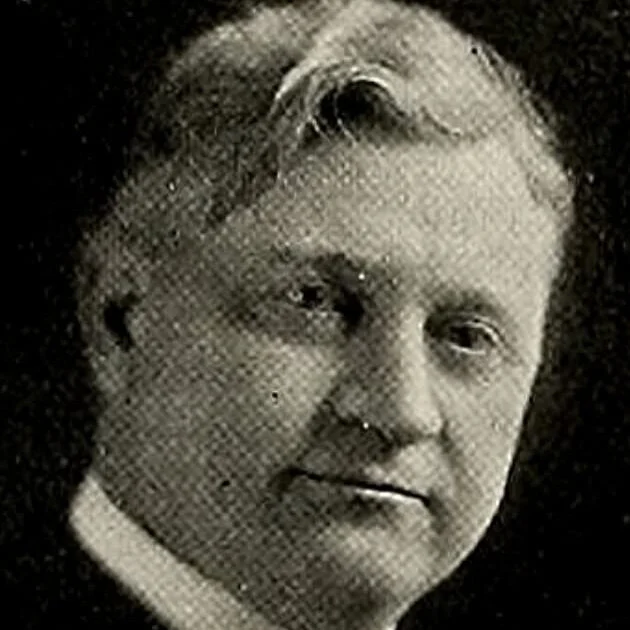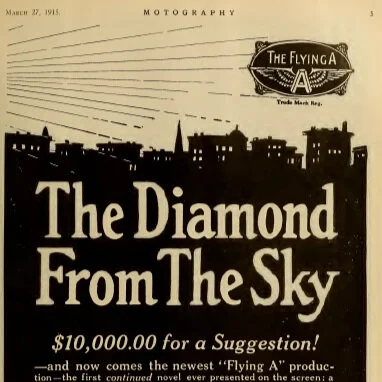John R Freuler
There is a tendency among film researchers to focus on personalities from the West and East Coasts, while ignoring those from the ‘flyover’ states. This is to the detriment of our understanding of the early film industry, because much of the motivation for growth prior to WWI came from Chicago and Milwaukee. Between 1914-1919 the most prominent personality in Chicago film making and distributing was John R. Freuler. Like Leon Goetz, Edith May Leuenberger and William Wesley Young, Freuler was a native of Monroe, Wisconsin— another star in this odd constellation of personalities which made our small farming community strangely prominent on the national stage during the 1910-20 period.
John R. Freuler launched the “star system” when he signed Chaplin on with Mutual through the contract mentioned above. Chaplin, a devoted socialist, enjoyed friendships with some of Europe’s more controversial public figures, such as ‘raging reporter’ and would-be socialist dictator Egon Erwin Kisch.
Freuler got his start in business through the Milwaukee real estate market and owned his first movie theater as the result of a bad loan he made to an unnamed acquaintance. Instead of winding up this hole-in-the-wall establishment, Freuler decided to take over management of the theater himself. This was not a decision he was proud of, in fact, Freuler was clearly ashamed of it. He would avoid looking at the establishment when passing; surreptitiously check its business proceedings; and didn’t tell his friends or family about his new business venture. Such deception begs the question: “What sort of films were being shown there?” Film historians have as yet been unable to answer that question, but during his stewardship of Mutual Film and its daughter production companies, Freuler had a tendency to push the boundaries regarding sexual topics— and, of course, market these films as moral education aids, complete with a battery of ministers, priests, doctors and educators on hand to back up his claims.
“Damaged Goods”: one of the Mutual releases which Freuler championed. The film dealt with a party-loving family man who brings home syphilis…
“Charity?”, a 1914 Mutual release written by D. W. Griffith’s wife Linda, was another questionable offering from Freuler. This real-life inspired drama about children exploited by the White Slave Trade premiered at Ziegfeld’s theater in Chicago…
Freuler was by no means alone in his pursuit of such subject matter, the ‘independent’ film producers at this time all seem to have been very forward in this regard. What was different about Freuler was his public stature and ability to organize leaders in the industry. Freuler was the leading film industry personality combating federal and local attempts at regulating pornography— or more accurately, keeping censorship in the hands of the boards of film production and distribution companies. He was also one of the key figures mobilizing the industry in service of the war effort from about 1916 onward. Readers will notice that is a year prior to US entry into WWI.
WWI and propaganda efforts leading up to American involvement in WWI are key to understanding the early film business in North America and Europe. Prior to US hostilities, John Freuler made numerous trips to the U.K. and the Continent to study the moving picture industry there. At this time the leading foreign powers funding war-related propaganda in the USA were Imperial Germany and Great Britain.
Although the text-book date for the start of WWI is 1914, the military events leading up to official war were underway by 1913 and strategic military planning was already at an advanced stage. Imperial Germany was pushing a strategy designed to keep the USA out of the war, while Great Britain was doing everything in her power to pull us in. To this end, Berlin sent funding to agitators like Pancho Villa in Mexico, whose terrorism along the US border occupied both Washington’s and the military’s attention. It is not an accident that in 1914 Freuler produced D. W. Griffith’s movie “The Life of General Villa” starring Villa himself, as well as the pacifist movie “The Birth of A Nation” one year later.
Pancho Villa historical….
Pancho Villa re-imagined by John Freuler, D. W. Griffith and Albert Edward ‘Raoul’ Walsh in 1914.
Mutual Film, Freuler’s movie distribution company, had received financing from Kuhn, Loeb & Co and accepted Otto Kahn, one of the bank’s partners, as a board member. Kahn was a German-born banker with close connections to expatriate German communities in New York City and London (particularly through Deutsche Bank); he was widely believed to have acted as an Imperial German financier and propaganda agent during the early years of WWI in Europe.
1914 “The Life of General Villa” advertisement, courtesy of IMDb. Contemporary American audiences would have noticed a comparison to the Confederate Army through the ‘rebel’ reference.
Another advertisement for “The Life of General Villa”, with even more pronounced comparisons to the struggle faced by Confederate states during the US Civil War.
Griffith created “The Birth of a Nation” as an anti-war movie, this advertisement is courtesy of NCpedia.org.
It was around the time of “The Birth of a Nation” that some upset happened which flipped Freuler’s patronage to the British Imperial side. Kahn was against the production of this movie; there are conflicting stories as to why. Certainly Kahn’s firm’s founders’ fortunes had flourished in the aftermath of the American Civil War and trade journal coverage of Kahn’s involvement in Mutual falls dramatically after 1915. Freuler agreed with Kahn, and “The Birth of a Nation” was only made because Freuler’s partner Harry E. Aitken financed it with company funds without Freuler’s knowledge. The fallout of this nasty episode left Freuler as sole head of the firm, while Aitken left with star director Griffith. By 1916 Freuler’s company was staunchly, some would say even obscenely, pro-war. “Preparedness” films were all the rage, and Freuler even came out with a submarine-based dramatic serial called “The Secret of the Submarine”.
From IMDb: Freuler’s pro-war serial about submarines, then an exciting new weapon, even got the endorsement of Teddy Roosevelt. Read about movie projectionist Leon Goetz’s weird 1910 submarine patent here.
Readers may wish to refresh their memory of Leon Goetz’s flirtation with submarines in 1910, a military project championed by the same “T. R.” who is mentioned in the above advertisement. Freuler’s patronage paid off for him, as he was appointed to be the Navy’s film industry contact via the Department of Public Information.
Motion Picture Herald, March 28th 1942.
I could carry on a long time about Freuler, and my upcoming book will provide the most thorough examination of his career available. I will end here by noting that he had a connection with William Wesley Young too, through business partner and film industry insider Benjamin Hampton. Hampton was Young’s boss at “Hampton’s Magazine”, where Young would have come into contact with people of New York’s avant-garde like Florenz Ziegfeld and A. A. Brill.
















